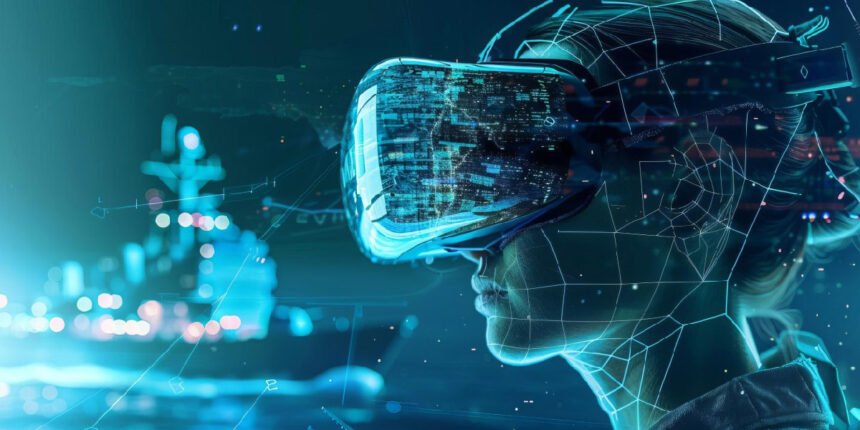Introduction
In the ever-evolving landscape of immersive technology, the term m100pvvr has emerged as a fascinating topic of discussion among tech enthusiasts and futurists alike. Although still in its conceptual phase, m100pvvr represents the potential dawn of a new generation of portable virtual and visual reality systems. Combining high-resolution displays, lightweight ergonomic design, and cross-platform compatibility, this device is speculated to deliver an unparalleled immersive experience across industries such as education, healthcare, gaming, and industrial operations.
While official confirmation and specifications are scarce, what sets m100pvvr apart is its promise to overcome the core limitations of current VR/AR hardware through innovation in both design and function. As we explore this prototype’s theoretical features and use cases, one thing becomes clear—m100pvvr may be the precursor to the next leap in how we perceive and interact with digital environments.
What is M100PVVR?
The name m100pvvr likely breaks down into distinct components, each suggesting a function or classification. The “M100” possibly refers to a model number or series, potentially denoting a modular design or a first-generation product in a line of immersive systems. The “P” may stand for Portable or Professional, indicating that the device is intended for on-the-go or enterprise use. The “VVR” portion is most probably short for Visual and Virtual Reality, implying that this is not just a VR headset but a more comprehensive system capable of delivering layered, high-fidelity visual experiences.
Taken as a whole, m100pvvr can be seen as a cutting-edge conceptual VR/AR device built for standalone use and integrated functionality. While it hasn’t officially hit the market or been announced by a major company, it is widely discussed in speculative tech forums and developer circles as a promising challenger to existing headsets such as Meta Quest 3, Apple Vision Pro, and Microsoft HoloLens.
M100PVVR: Quick Facts & Estimated Specs Table
Estimated Technical Specs
| Feature | Details |
|---|---|
| Model Name | M100PVVR |
| Type | Portable Visual & Virtual Reality System |
| Display | 4K–8K per eye (speculative) |
| FOV | 100°–120° wide field |
| Tracking | 6DoF, Hand + Positional |
| Weight | Under 300g |
| Connectivity | Wi-Fi 6E, Bluetooth 5.3, USB-C |
| Processor | Snapdragon XR2 or equivalent |
| Battery Life | 2–4 hours |
| Audio | Spatial, built-in speakers & microphones |
| Platforms | Windows, Android, iOS, WebXR |
| Price Range | $800–$2000 USD (estimated) |
| Status | Concept/Prototype |
The Evolution of Virtual Reality Technology
Virtual reality has come a long way from its rudimentary roots in the early 90s, where polygonal environments and limited head tracking were the norms. The launch of the Oculus Rift and HTC Vive marked major milestones in immersive consumer experiences, pushing VR into mainstream awareness. These devices introduced significant breakthroughs like room-scale tracking, real-time rendering, and controller-based interaction. However, the early excitement was often offset by physical limitations, including bulky headsets and dependence on high-powered PCs.
More recently, devices like Meta Quest and Apple Vision Pro have made strides toward all-in-one wireless systems. Yet even these models have trade-offs in terms of weight, battery life, or cost. The emergence of m100pvvr as a lightweight, powerful, and modular VR/AR device symbolizes the next logical evolution—a future where users can access high-performance immersive environments without sacrificing mobility or comfort.
Limitations in Current VR Systems
Despite rapid advancements, modern VR systems still fall short in several areas. First, weight and comfort remain significant issues. Even the latest headsets often exceed 500 grams, leading to fatigue during prolonged use. Second, battery life is another bottleneck. Most standalone systems barely last beyond 2–3 hours on a full charge, limiting their practicality in professional settings. Third, software ecosystems are still heavily skewed toward entertainment and gaming, with insufficient content tailored to education, healthcare, or remote work.
Fourth, the setup complexity of some systems can be daunting for non-technical users. Fifth, tracking inconsistency and motion sickness continue to plague experiences, especially in lower-end models. These pain points have created a demand for a solution that is lighter, smarter, and more adaptable—precisely where m100pvvr may find its sweet spot.
How M100PVVR Solves Today’s VR Challenges
The m100pvvr concept appears to address many of these challenges head-on. By focusing on a lightweight, wearable design, it minimizes the strain typically associated with bulky headsets. With speculative display resolutions of up to 8K per eye, users can expect crystal-clear visuals that significantly reduce eye strain and enhance realism. Full 6DoF tracking with advanced gesture and body recognition offers intuitive interaction, eliminating the clunky interface barriers of older systems.
Additionally, the potential inclusion of an integrated XR2 chip or similar processor suggests standalone capabilities, removing the need for tethering to external systems. With multi-platform support anticipated—including WebXR, Windows, Android, and iOS—m100pvvr could seamlessly fit into existing ecosystems. These factors, combined with thoughtful ergonomics and high-end audio integration, may make it a compelling option across both consumer and enterprise landscapes.
Top 6 Features of M100PVVR
1. Ultra-High Display Resolution
One of the standout speculative features of m100pvvr is its display technology, rumored to deliver between 4K and 8K resolution per eye. This level of clarity enables lifelike textures, accurate depth perception, and reduced pixelation, creating a hyper-realistic visual experience. Such capabilities are critical for fields like medicine, architecture, and education, where detail accuracy directly influences outcomes.
2. Lightweight, Wearable Design
With an estimated weight of under 300 grams, m100pvvr promises a user-friendly, comfortable experience. Lightweight hardware encourages longer session times, making it suitable for remote work, virtual meetings, and lengthy educational sessions. Breathable materials, balanced distribution, and adjustable straps are likely part of the ergonomic considerations.
3. Advanced Tracking System
Featuring 6 Degrees of Freedom and full positional plus gesture tracking, m100pvvr aims to create a responsive, intuitive user interface. From hand motions to full-body locomotion, the system would enable natural interaction in digital environments. This technology would support applications ranging from surgical training to immersive gaming.
4. Powerful Integrated Processor
The inclusion of a Snapdragon XR2 or equivalent ARM-based chip would enable m100pvvr to function as a standalone system, eliminating reliance on external GPUs or desktop computers. This opens new avenues for mobile learning, field operations, and travel-friendly enterprise deployments.
5. Multi-Platform Compatibility
Compatibility across Windows, Android, iOS, and WebXR suggests that m100pvvr is built for integration into existing tech stacks. Whether you’re using it for a virtual meeting, a training module, or a real-time simulation, this interoperability ensures users are not locked into a single ecosystem.
6. Spatial Audio & Microphones
Audio plays a vital role in immersion, and m100pvvr is expected to feature spatial sound technology along with built-in microphones and speakers. This would be ideal for remote communication, ambient soundscapes in gaming, and accurate diagnostics in medical simulations.
Real-World Applications of M100PVVR
Education and Training
M100PVVR could transform education by providing immersive learning experiences. Students might explore 3D models of molecules, historical sites, or mechanical systems in interactive detail. Teachers can conduct live virtual classes in realistic, responsive environments, making abstract concepts tangible.
Healthcare
In medicine, m100pvvr has the potential to revolutionize training, diagnostics, and therapy. From simulating surgical procedures to guiding physical therapy through gamified interaction, the headset could serve as a non-invasive, risk-free tool for patient care and professional development.
Industrial & Field Operations
Technicians and field workers could use m100pvvr to overlay AR schematics, perform guided repairs, or conduct remote inspections. This would reduce human error and allow real-time assistance from off-site experts, improving both safety and efficiency.
Remote Work & Collaboration
M100PVVR could redefine remote workspaces, allowing professionals to share virtual offices, manipulate 3D designs collaboratively, or conduct realistic walkthroughs with clients from anywhere in the world. This level of presence and interaction would greatly enhance productivity.
Gaming and Immersive Media
For gamers and content consumers, m100pvvr offers next-generation entertainment. Whether it’s cinematic VR, multi-player adventures, or interactive storytelling, the possibilities are endless. Developers can also experiment with new genres that blur the lines between reality and fiction.
How M100PVVR Stacks Up Against Competitors
Compared to current leaders like Meta Quest 3, Apple Vision Pro, HoloLens 2, and Magic Leap 2, the m100pvvr stands out due to its projected portability, standalone operation, and high-resolution capabilities. While Meta Quest targets mass-market affordability and Apple Vision Pro focuses on high-end luxury and productivity, m100pvvr may occupy a unique middle ground—balancing professional performance with mobility. Its potential modularity and platform agnosticism could give it an edge in enterprise deployments, where flexibility is key.
Challenges Ahead for M100PVVR
Despite its promise, m100pvvr will face several hurdles. Battery technology remains a bottleneck for high-performance portable devices. Without innovation in power management, long sessions may be constrained. High production costs could also make it inaccessible to mainstream consumers. Additionally, a lack of a mature content ecosystem, especially outside of gaming, might hinder early adoption. User onboarding, including comfort with new interfaces and software, will be critical. Lastly, data privacy and cybersecurity, especially in healthcare and enterprise contexts, must be prioritized for trust and compliance.
What Experts and Enthusiasts Are Saying
While no formal announcements have been made, m100pvvr is quietly gaining traction in tech communities. Enthusiasts on Reddit and VR forums speculate that it could be the spiritual successor to discontinued experimental projects or a stealth development by a major hardware player. Some developers have even created concept mockups, imagining what this system could look like. YouTube reviewers have discussed the possibility of such a device filling the gap between casual users and enterprise-grade systems, especially in niche industries.
The Future of M100PVVR and Immersive Tech
Looking forward, m100pvvr may evolve into a platform that integrates AI-powered virtual assistants, AR/VR hybrid functionality, and metaverse compatibility. Whether used for virtual campuses, live simulation environments, or digital social hubs, the scope is enormous. As cloud rendering and 5G/6G networks mature, latency issues will diminish, allowing even richer experiences. Tools for accessible content creation, especially for non-developers, will be key to unleashing its full potential. For underfunded schools, remote hospitals, or small businesses, m100 pvvr could offer powerful tools once reserved for elite organizations.
Final Thoughts
The m100pvvr may be conceptual for now, but its implications are very real. With a focus on portability, precision, and cross-functional utility, it represents a major leap in immersive technology. As industries across the board demand more efficient, more interactive, and more intuitive digital environments, m100 pvvr is poised to be a frontrunner—especially if it succeeds in balancing performance with accessibility. For those tracking the evolution of XR, now is the time to watch closely. What begins as a prototype today could be tomorrow’s industry standard.
FAQs About M100PVVR
What is M100PVVR?
M100PVVR is a conceptual portable virtual and visual reality system designed for immersive experiences in education, healthcare, gaming, and remote collaboration. It is expected to feature high-resolution displays, advanced tracking, and cross-platform support, all in a lightweight and standalone headset.
Is M100PVVR available to buy?
No, M100PVVR is not currently available for purchase. It is still considered a concept or prototype and has not been officially released by any manufacturer as of now.
What are the main features of M100PVVR?
Key features of M100PVVR may include 4K–8K display resolution per eye, 6DoF tracking, under-300g weight, spatial audio, standalone processing power, and compatibility with Windows, Android, iOS, and WebXR platforms.
How is M100PVVR different from other VR headsets?
Unlike many current VR headsets, M100PVVR is expected to be more lightweight, portable, and versatile. It aims to offer high-end performance without needing external hardware, making it ideal for both professional and everyday use.
What can M100PVVR be used for?
M100PVVR can be used for virtual education, medical training, industrial simulations, remote work collaboration, gaming, and immersive entertainment. It is designed to bring realistic, interactive environments to users across many industries.
For More Information, Visit Fourmagazine







